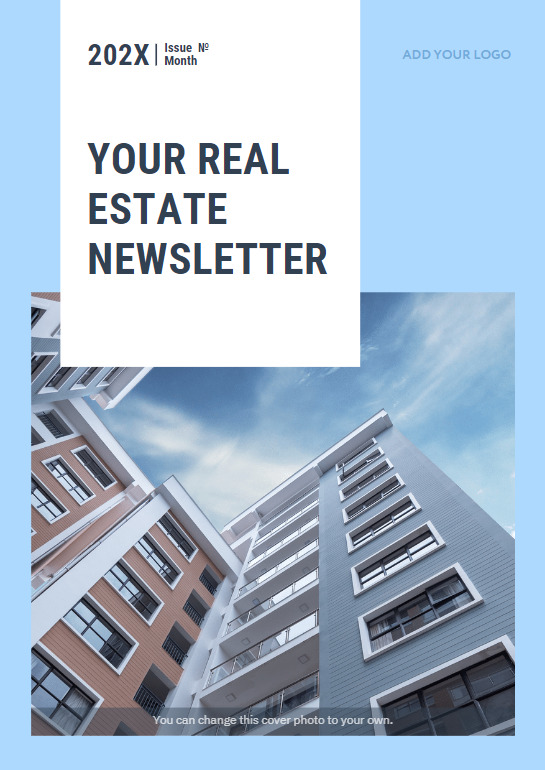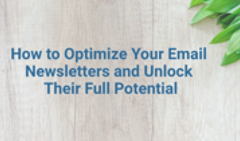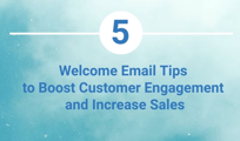Make an awesome value-packed real estate newsletter, they say. Cut through the noise, they say. Otherwise, it won’t work.
Easier said than done, because there are only so many topics in the real estate industry, and every one of your competitors, who’s worth anything, is well aware of them. Chances are your subscribers’ inboxes are bursting with listing updates and market statistics with a sprinkle of upcoming events and blog round-ups. Among a hundred other ‘Greetings from…’ and ‘ABC’s Monthly Digest.’
So should you just give up?
Oh no, no way. In 2026, enewsletters are still an important part of any sensible email marketing strategy and the best way to engage with the audience. Newsletters help you build a connection, create a sense of community, and foster relationships that won’t just turn readers into clients—but strengthen your brand and send new leads your way as well.
And if you want to succeed, it’s not only about real estate newsletter ideas, but the overall approach to newsletter publishing that you should think about.
In this article, we’ll discuss the best real estate newsletter practices, topic ideas, and tools you can use to step up your newsletter game.
Real Estate Newsletter Basic Ideas
It doesn’t matter what’s inside your newsletter if no one opens it. So how can you improve your chances of success?
1. Make the Newsletters as Personalized as Possible
Just a name and email address simply won’t do. Are they buyers or sellers? What kind of property and neighborhood are they looking for and why? What’s their budget?
You can discover tons of useful information by sending quizzes or polls. You can do a fun one such as Trulia’s ‘This or that?’, which will give you insights into what your subscribers prefer:
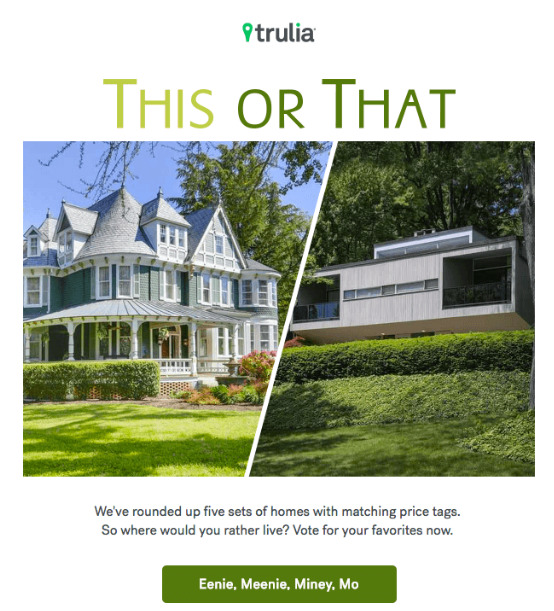
Source: Follow Up Boss
Or do a more formal one like Redfin’s ‘Affordability calculator’.
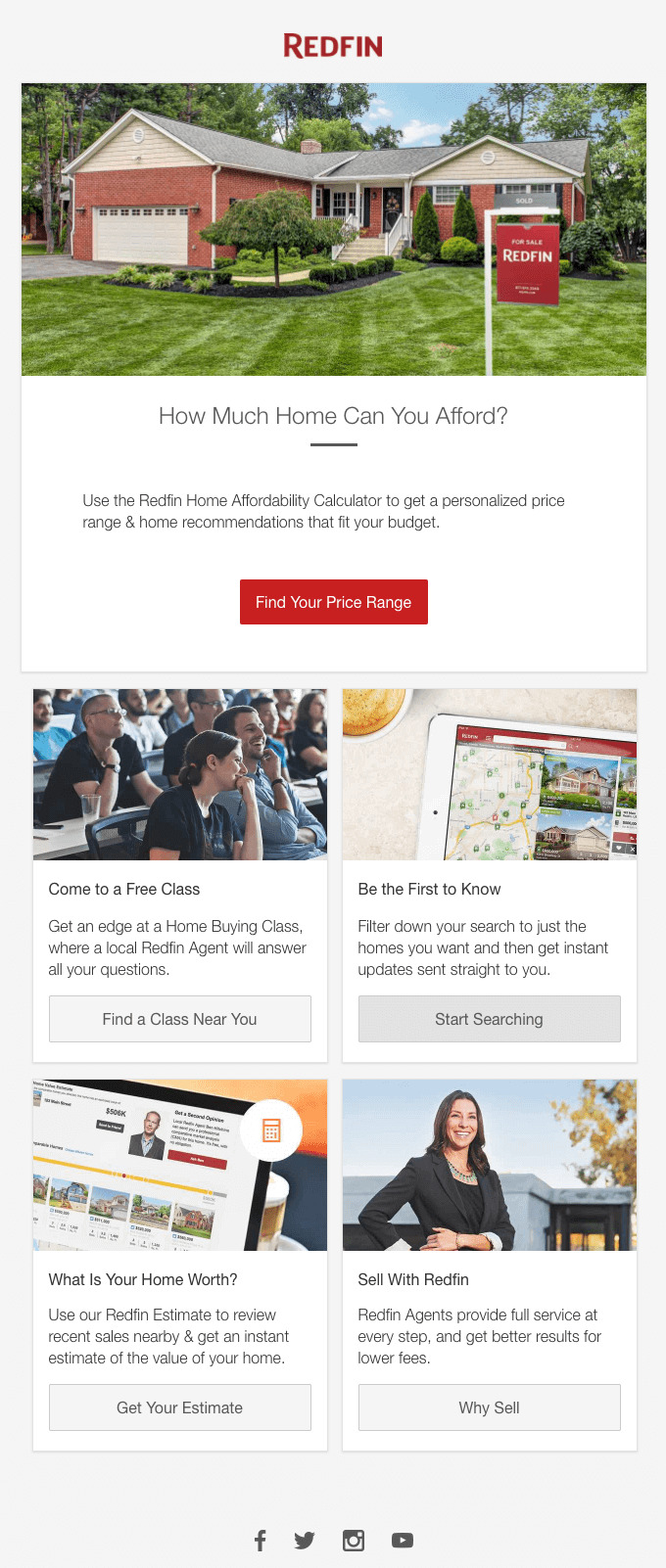
Source: mailbakery
Once you’ve collected enough data, you can group your subscribers based on the attributes you find most relevant and go from there. This alone can boost your open rates up to 14% and click rates up to whopping 100%.
2. Keep Your Subject Lines Short and Engaging
This is a tricky piece of advice, because despite numerous statistics it’s not hard science, and you will probably have to learn what works for you through trial and error.
Just remember that people open your emails on mobile devices, and most smartphones display five to six words, so brevity is key. Being personal and informational also pays off, because it shows that you care about your subscribers and their time. Here are some good examples if you need inspiration.
3. Use a Visually Appealing Design
Whether you create short email newsletters or go for longer, more comprehensive pieces, professional design is a must if you want people to keep coming back.
Good design doesn’t mean ‘fancy’, it simply follows a few rules:
✅ Keep your layout short and easy to navigate around.
✅ Optimize for mobile devices: use bigger fonts, and break texts into smaller paragraphs.
✅ Use high-quality images, branded elements, and a coherent color scheme.
✅ Use multimedia: the more diverse your content formats are, the better they engage. Try videos, GIFs, and online forms in addition to texts for maximum interactivity.
If you don’t have an in-house designer or your designer has their hands full with other tasks, try using templates! Many email providers and design platforms offer quality customizable templates that often come free. Using a template will save you tons of time and effort without compromising your real estate newsletter’s beauty.

source: Canva
4. Include Clear Call-To-Actions
Do you use real estate newsletters to encourage more people to book a consultation with you? Browse your current listings? Or, perhaps, download a paid ebook? Then don’t forget to include various call-to-actions throughout the content to guide people toward the intended action.
Make sure your CTAs are visually distinct so your readers don’t accidentally miss them.
5. Send Out Your Real Estate Newsletter Regularly
Maintaining a regular sending schedule will keep your audience engaged and looking forward to your next update. There’s no universal rule about the frequency of emails: some people prefer to receive news once a month, while others think a week is too long and want to hear more from you.
The best choice is to let people choose the frequency of real estate newsletters themselves, but if you cannot afford complex segmentations, sending a biweekly or monthly newsletter is a pretty safe choice.
Content Ideas for Real Estate eNewsletter
Now, what can you put into the content of your real estate newsletter?
#1 Listing Updates
This one feels like an obvious choice, but it can work wonders if you focus on relevance and personalization, as we’ve discussed above. It can engage passive leads and help convert them to clients, show off your expertise as a real estate agent, and build trust. In this example from Zillow, you can see how wonderfully they utilize their data, showing the fitting listings while also gently nagging the lead to take action.
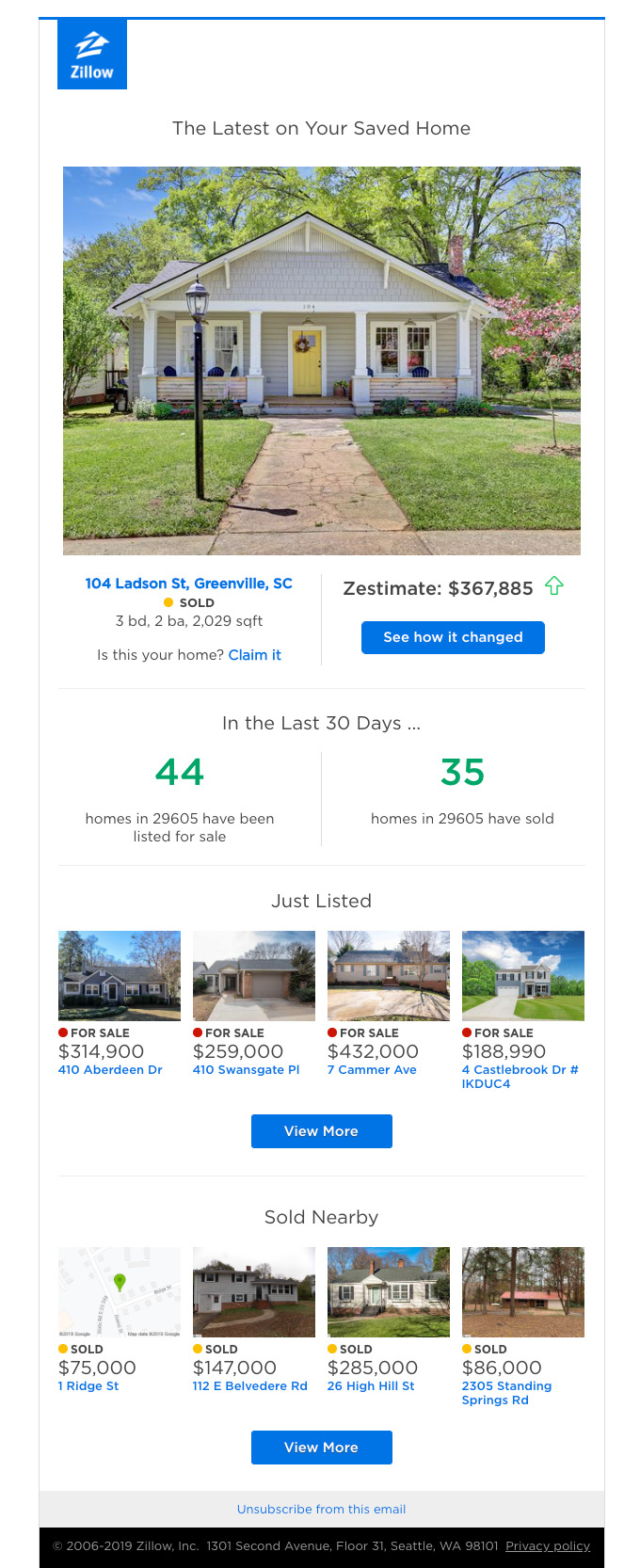
#2 Market Trends and Statistics
Again, market updates may not sound very exciting, because everybody does them. But it’s an excellent way to build trust with sellers and secure more listings. To succeed, your market updates should be educational and friendly—and personal. Use first names, segment the emails based on location, showcase the property you’ve sold. This way people will feel their homes are in good hands.

Source: Venngage
#3 Neighborhood Spotlights
A wonderful opportunity for you, as a real estate agent, to keep in touch with your audience. You can turn this kind of newsletter into a light and fun weekly or monthly digest, listing upcoming events and places to visit, suggesting some seasonal activities and the best biking routes. It’ll allow you to keep the balance between promotional and helpful content, and make people feel like they are a part of a community.
#4 Local Real Estate News
This is the section for people interested in the real estate market opportunities: rental owners or potential investors. Here you can cover anything from new residential and commercial development projects to local government decisions affecting the local market. It is also a good place to announce open houses and property showings, encouraging potential buyers to explore current listings.
#5 How-To Guides and Selling Tips for Homeowners
Everybody loves educational content, so this can easily become your real estate newsletter hit. Buyers will enjoy a home-buying guide, as the whole process can be extremely confusing. Sellers will benefit from suggestions that will help them improve prices or increase offers.

Source: Fiverr
💡Sometimes you may feel like you need more space for large content like a comprehensive guide that your newsletter can fit in. In this case, you can pack it as a downloadable PDF or a flipbook and give just a preview of the guide in the newsletter.
#6 Video Content
Including video in your real estate newsletter can increase your click-through rates by up to 300%. So if you already have some video content, be it a drone video of the neighborhood, a home tour, a resident interview, or a personal hello from you or your agents, don’t hesitate to use it in your newsletters. It will pay off in a loyal, engaged audience that will have a personal connection with your brand.
If you feel like investing in a more complex project, you can even create a series of educational videos on buying a home or on finances, for example. The task may be daunting, but as a result, you will get loads of evergreen content you can use across your marketing.
#7 Home Improvement Ideas
Property owners will appreciate ideas on how to increase the property’s value through home improvement. The advice can range from simple DIY tips like painting the walls or updating hardware to full-scale renovation projects such as bathroom or kitchen remodeling or converting an attic into an additional living space.
Take inspiration from this wonderful real estate brochure by the American Apartment Owners Association:
Your readers will also appreciate info on how to go about planning out a home improvement project as well as actionable advice on how to choose reliable contractors.
You can even turn this into a regular section of your newsletter and wrap everything into a downloadable guide once you have enough material.
💡Feature advice from an experienced interior designer or a builder to back up your tips.
#8 Property Management Tips
Novice property owners have tons of questions, while people who’ve been in the business for a while want to stay on track with the latest news and changes. Here are just a few ideas of what to highlight on the topic:
✅ Tenant screening and background checks
✅ How to go about accommodation requests
✅ Tax and legal advice
✅ Building relationships with tenants
✅ Rent collecting strategies
✅ Turnover strategies
✅ Property management software overview
#9 Environmental and Sustainable Living Ideas
Utility bills have become a big issue for renters and property owners alike. Offer advice on how to conserve energy by switching to LED lights, installing solar panels and smart thermostats, and upgrading insulation.
On top of suggesting changes that require investment, you can give some simple yet effective tips, like rainwater harvesting, composting, and turning to local recycling options. Perhaps, you can even inspire your local community to organize a garage sale!
These measures will not only help reduce the bills but also make the property more attractive for potential buyers and comfortable to live in.
#10 Financial Advice
Taxes, insurance, building costs, mortgage, investment strategies—finance is a hot topic in the real estate world. Your readers will appreciate advice on how to save money and maximize their investments. Plus, covering financial topics will help you strengthen your position as an industry expert. Here are some topics you can highlight in your newsletters to cater to different audiences:
✅ Breaking down the initial costs of buying a home
✅ Choosing the right mortgage strategy: fixed-rate vs. adjustable-rate, refinancing
✅ Rental properties: how to choose, how to calculate potential expenses and returns
✅ Tax deductions and credits for homeowners
✅ Homeowner insurance: what it typically includes, how to go about emergencies such as flooding
✅ Incorporating real estate into retirement planning, whether through generating rental income or investing in real estate funds
#11 Success Stories
Moving on to the lighter topics—share stories of successful deals you or your agency helped to close. People love drama, so the more challenging the case was, the better! You can include before-and-after property photos, testimonials, and strategies you used to find that perfect home for your clients.
Plus, coming back to the benefits of video content, a video testimonial from a happy client can become a highlight of the entire newsletter. Video storytelling is much more powerful in terms of evoking an emotional response, so make sure to use it when the opportunity appears.
#12 Expert or Guest Columns
Guest columns are not only a way for you to save time and effort creating the content yourself but also a great opportunity to collaborate with other experts in the real estate field. You can choose to give a spot to local business owners, home inspectors, financial advisors, or landscape and interior designers. The tone of the column can be humorous or, on the contrary, serious, and the variety of topics you can discuss there is limitless, bringing your readers diverse perspectives and insights.
#13 FAQ Section
Answering your audience's questions can be a wonderful way to engage people. You can ask your readers to leave their questions on social media or through email, gather the most popular or relevant ones through voting, and then reply to them in your real estate newsletter.
On top of providing valuable information, selecting the questions themselves can spark some interesting conversations and raise your audience engagement overall.
#14 Real Estate Technology Updates
New technologies are rushing us into the future and impact almost every aspect of our lives—the real estate industry not being an exception. People are both worried about this fact and fascinated by it, so covering such things as virtual tours or using AI in property evaluation will undoubtedly draw a lot of attention.
You can share your experience with the new technologies, or how they impact the industry in general—or encourage people to share their hopes and fears and incorporate them into your articles.
How to Make Your Real Estate Newsletters Stand Out from the Competition?
As we’ve already discussed, the number of real estate newsletter topics is limited, so even if you’re producing exceptional content, it may get lost in the subscriber’s inbox.
But if the content is traditional, the newsletter format doesn’t have to be. With FlippingBook, you can turn your email or a PDF into an interactive online newsletter that is bound to attract your audience’s attention.
Create yours
Here’s how FlippingBook gives your newsletters a competitive edge:
Interactivity
Interactive ebooks are listed among the top five most effective types of interactive content according to the Content Marketing Institute. The newsletters created with FlippingBook are not only life-like and fun to flip through—with them, you can add videos, popup images, GIFs, and even lead capture forms to grow your subscriber list. So pack your newsletters with house tours, neighborhood spotlights, event previews, and other exciting bits that will help nurture your leads.
Ease of reading on any device
Thanks to cloud hosting, your newsletters are available via online links and can be opened and read on a smartphone or a big screen at any time. This is good news because you no longer have to worry about the content's length. Pack your newsletter with listings and recommendations, include blog round-ups, and educational videos—your subscribers won’t have to download anything or skip the email because it’s too long for their mobile screen.
What stands out the most in digital newsletters is how the content is organized: floorplans, renderings, and detailed descriptions are presented in a digestible and easily navigable format, helping our audience stay engaged and understand the details without feeling overwhelmed.
Activity tracking for better marketing and sales results
With FlippingBook newsletter analytics, not only will you know if people read your real estate newsletter, but also for how long and which part of the content they enjoyed the most.
Being able to track your newsletter can also turn it into a profitable sales tool: you’ll know how many clicks your ads and banners get and will be able to show your sponsors how much value your newsletter brings in specific numbers.
Check out a short video to learn how FlippingBook can help you outshine your real estate competitors with your interactive brochures and newsletters:
How Does It Work?
As a busy realtor, you will appreciate how easy it is to create an interactive newsletter with FlippingBook. All you need is a PDF and an Internet connection; FlippingBook will do the rest. It will convert your PDF file into an online flipbook in a matter of minutes. From there, you can customize it, grab a lin,k and send it to your subscribers.
You can email it or share it via social media and your website to maximize your online presence. The choice is yours.
Bonus: a Free Real Estate Newsletter Template
You can create your interactive real estate newsletter even faster with our free template for Canva.
If you’re not familiar with Canva, it’s an easy-to-use design tool that lets you create all sorts of marketing materials. You can customize the template we provide with your own images and text and then send your work straight to FlippingBook. There you’ll be able to add all the interactive elements you need, and share the finished newsletter with the world!
Ready to create your interactive real estate newsletter?


